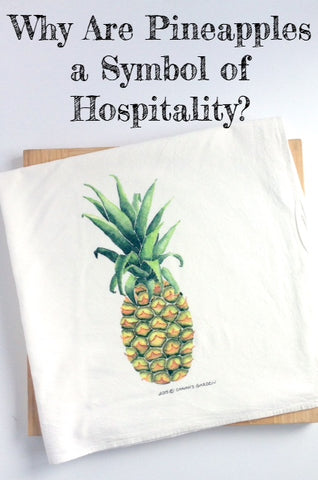Their weird prickly-looking exuberance alone makes pineapples
irresistible.
Originally from South America, the pineapple was traded by the First Peoples and so eventually made its way to what we call the Caribbean Islands.
In one of his trips across the Atlantic, Christopher Columbus (& Co) encountered a village where the food choices were apparently human stew (yes, cannibalism) and pineapples. Not surprisingly they choose pineapples. Pineapples were considered a sign of hospitality first by the Carib peoples themselves, being used in any great feasting celebration and by putting a pineapple just outside of a village entrance. This meant "Welcome" to visitors, which the Spanish quickly learned.
It was called "anana" which meant "excellent fruit." While most European countries kept this Carib name or only modified it slightly, like the French "ananas," the English preferred to capture its strangeness in its name: tall and prickly like a pinecone, but fleshy and sweet inside like an apple. Hence pineapple.
The challenge of getting them back to the Old World without rotting made them all the more rare and precious. This confined their realm mainly to royalty, as only the most wealthy could afford them. In the Old World, the craze for them took off like wild fire but growing the tropical fruit in non-tropical Europe proved to be quite a challenge. The Dutch were the first to invent a way to grow-warmer clime fruit up north: the fruit wall.
This photo of an old Dutch fruit wall in Clinendael, The Netherlands is from nl.wikipedia.org.
Kris De Decker gives the history of this invention in the wonderful article "Fruit Walls: Urban Farming in the 1600s" in Low Tech Magazine. During the day, the bricks would absorb enough warmth to keep the plants near them warm at night as well. The English needed a bit more given their even cooler climate, so they went on to invent the heated fruit wall. Their walls had a wider, hollow base so fires could be build inside the wall and keep the plants even warmer, something pineapples definitely needed.
Their symbolism in the New World, particularly in the southern colonies, built on all of this. The trip from the Caribbean to the colonies could still be too long for the fruit, so the king of fruits still reigned supreme. As a hostess, your greatest sign of hospitality would be to have a pineapple for your guest to eat. And like in the Carib villages, a house or plantation that placed a pineapple out front meant that sailor and man of the house was home and welcomed visitors.
And of course it took off from there: anything could be carved or made to have a pineapple on it, and if it did, it was all the more welcoming. Everything from door knockers to bedposts. The most dramatic example might be the Dunmore Pineapple cupola in Scotland.

This photo from the Dunmore Estate Scotland is via en.wikipedia.org.
And the theme persists to this day. The hotel in Seattle where I had all my wedding guests stay is part of the "Pineapple Hospitality" hotel chain. So if you want to give a wonderful hostess or house warming gift, think pineapples. You can give the pineapple tea towel seen at the beginning of this post, a string of tiny pineapple lights, a pineapple doormat, the options are endless.
But most important is the spirit of welcome and openness that the pineapple symbolizes.


